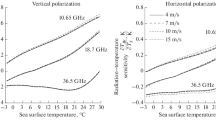Abstract
Among the regression-based algorithms for deriving SST from satellite measurements, regionally optimized algorithms normally perform better than the corresponding global algorithm. In this paper, three algorithms are considered for SST retrieval over the East Asia region (15°–55°N, 105°–170°E), including the multi-channel algorithm (MCSST), the quadratic algorithm (QSST), and the Pathfinder algorithm (PFSST). All algorithms are derived and validated using collocated buoy and Geostationary Meteorological Satellite (GMS-5) observations from 1997 to 2001. An important part of the derivation and validation of the algorithms is the quality control procedure for the buoy SST data and an improved cloud screening method for the satellite brightness temperature measurements. The regionally optimized MCSST algorithm shows an overall improvement over the global algorithm, removing the bias of about −0.13°C and reducing the root-mean-square difference (rmsd) from 1.36°C to 1.26°C. The QSST is only slightly better than the MCSST. For both algorithms, a seasonal dependence of the remaining error statistics is still evident. The Pathfinder approach for deriving a season-specific set of coefficients, one for August to October and one for the rest of the year, provides the smallest rmsd overall that is also stable over time.
Similar content being viewed by others
References
Ahn, M. H., B. J. Hwang, E. H. Son, M. J. Kim, and A. S. Suh, 2001: Derivation of sea surface temperature from GMS-5 for the high resolution numerical weather prediction models. Korean Journal of Atmospheric Sciences, 4, 41–56.
Ahn, M. H., E. H. Son, and B. J. Hwang, 2003a: A new algorithm for sea fog/stratus detection using GMS-5 IR data. Adv. Atmos. Sci., 20, 899–913.
Ahn, M. H., J. M. Koo, C. Y. Chung, and J. C. Nam, 2003b: Effects of the tropospheric dust on the sea surface temperature derivation from the GMS-5 IR data. Journal of Korean Meteorological Society, 39, 653–666.
Barton, I. J., 1995: Satellite-derived sea surface temperature current status. J. Geophys. Res., 106, 8777–8790.
Bates, J. J., and W. L. Smith, 1985: Sea surface temperature: Observations from geostationary satellites. J. Geophys. Res., 90, 11609–11618.
Emery, W. J., S. Castro, G. A. Wick, P. Schluessel, and C. Donlon, 2001: Estimating sea surface temperature from infrared satellite and in situ temperature data. Bull. Amer. Meteor. Soc., 82, 2773–2786.
Gill, A. E., 1982: Atmosphere-Ocean Dynamics. Academic Press, 643pp.
Hansen, D. V., and P. M. Poulain, 1996: Quality control and interpolations of WOCE/TOGA drifter data. J. Atmos. Oceanic Technol., 13, 900–910.
Kilpatrick, K. A, G. P. Podesta, and R. Evans, 2001: Overview of the NOAA/NASA Advanced Very High Resolution Radiometer Pathfinder algorithm for sea surface temperature and associated matchup database. J. Geophys. Res., 106, 9179–9197.
Legeckis, R., and T. Zhu, 1997: Sea surface temperatures from the GOES-8 geostationary satellite. Bull. Amer. Meteor. Soc., 78, 1971–1983.
McClain, E. P, W. G. Pichel, and C. C. Walton, 1985: Comparative performance of AVHRR-based multi-channel sea surface temperature. J. Geophys. Res., 90, 11587–11601.
Minnett, P. J., 1990: The regional optimization of infrared measurements of sea surface temperature from space. J. Geophys. Res., 95, 13497–13510.
MSC, 1997: The GMS User’s Guide. Meteorological Satellite Center, Japan Meteorological Agency, 190pp.
Park, K. A., 1996: Spatial and temporal variability of sea surface temperature and sea level anomaly in the East Sea using satellite data (NOAA/AVHRR, TOPEX), Ph. D dissertation, Seoul National University, 294pp.
Pearce, A. F., A. J. Prata, and C. R. Manning, 1989: Comparison of NOAA/AVHRR-2 sea surface temperatures with surface measurements in coastal waters. Int. J. Remote Sens., 10, 37–52.
Rodon, G. I., 1975: On the North Pacific temperature, salinity, sound velocity and density fronts and their relation to the wind and energy flux field. J. Phys. Oceanogr., 4, 168–182.
Saunders, P. M., 1967: Aerial measurement of sea surface temperature in the infrared. J. Geophys. Res., 72, 4109–4117.
Shirakawa, Y., 1996: Sea surface temperature, Meteordagical Satettite Center Technical Note, Special Issue, 95–101.
Shenoi, S. C., 1999: On the suitability of global algorithms for the retrieval of SST from the north Indian Ocean using NOAA/AVHRR data. Int. J. Remote Sens., 20, 11–29.
Stramma, L., P. Cornillon, R. A. Weller, J. F. Price, and M. G. Briscoe, 1986: Large diurnal sea surface temperature variability: Satellite and in situ measurements. J. Phys. Oceanogr., 16(5), 827–837.
Walton, C. C., 1988: Nonlinear multichannel algorithms for estimating sea surface temperature with AVHRR satellite data. J. Appl. Meteor., 27, 115–124.
Walton, C. C., W. G. Pichel, and J. F. Sapper, 1998: The development and operational application of nonlinear algorithms for the measurement of sea surface temperatures with the NOAA polar-orbiting environmental satellites. J. Geophys. Res., 103(C12), 27999–28102.
Webster, P. J., C. A. Clayson, and J. A. Curry, 1996: Cloud, radiation, and the diurnal cycle of sea surface temperature in the tropical western Pacific. J. Climate, 9, 1712–1730.
Wu, X., P. Menzel, and G. S. Wade, 1999: Estimation of sea surface temperature using GOES-8/9 radiance measurements. Bull. Amer. Meteor. Soc., 80, 1127–1138.
Yasuda, H., and Y. Shirakawa, 1999: Improvement of the derivation method of sea surface temperature from GMS-5 data. Meteorological Satellite Center Technical Note, 37, 19–33.
Author information
Authors and Affiliations
Rights and permissions
About this article
Cite this article
Ahn, MH., Sohn, EH., Hwang, BJ. et al. Derivation of regression coefficients for sea surface temperature retrieval over East Asia. Adv. Atmos. Sci. 23, 474–486 (2006). https://doi.org/10.1007/s00376-006-0474-7
Received:
Revised:
Issue Date:
DOI: https://doi.org/10.1007/s00376-006-0474-7




